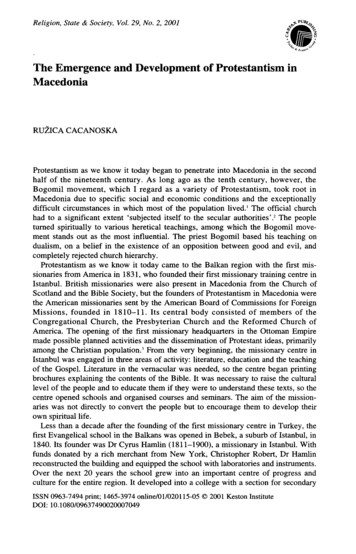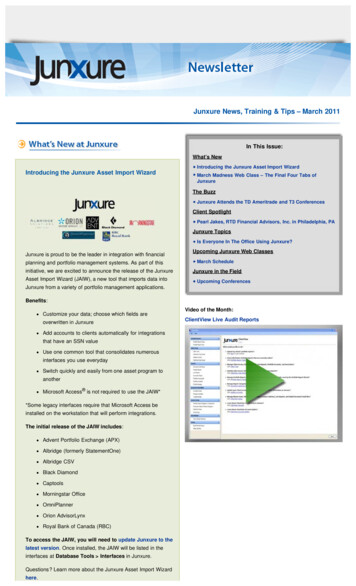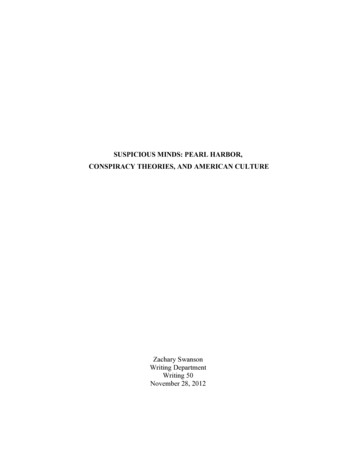
Transcription
U . S .D E P A R T M E N TAPRIL 2010Macedonia’sPearl of theBalkansO FS T A T EMAGAZINE
ContentsApril 2010Issue Number 544TheGreenReport10Greening ITBureau cuts energy use—one computer at a time.12Green TeamThe Sounding Boardgathers green ideas.14Green LeagueU.S. posts pledgeenvironmental awareness.16Sunny ForecastOBO installs solar panelsfor clean energy.
32Features1834Department advisors help DODbring Haiti relief.Raffle winners taste real-worldtraining with Diplomatic Security.20Post of the Month:38Unified ResponseSkopjeAncient Macedonia builds amodern democracy.Agents for a DayThe Active YearsRetired FSOs travel for freeas cruise ship lecturers.26Image EnhancerNGO fair seeks to win friendsin Argentina.28Timely DataHR releases 2009 Foreign Servicepromotion statistics.32House-RaisingConsul General staff builds ahome in Thailand.On the CoverBuilt in the late 13th century,The Church of the HolyMother of God-Peribleptosoverlooks Lake Ohrid, thePearl of the Balkans.Photograph by Getty ImagesColumns234737From the D.G.Letters to the EditorIn the NewsDiversity NotesEducation & Training40 Medical Report42 Appointments42 Retirements43 Obituaries44 The Last Word34
*Direct from the D.G.Presidential ManagementFellows and Career EntryProgram OpportunitiesThe Presidential Management Fellows and Career EntryPrograms are the two leading training and developmentprograms for Civil Service entry into the State Department.More than 100 employees entered the Department underthese programs during the past calendar year. These programs, and the employees they bring, are a tremendous assetas we, like our sister federal agencies, face a wave of retirementsdue to the aging of baby boomers.Approximately 17 percent ofthe Department’s work-force iscurrently eligible to retire. In 5years, that number will increase to34 percent, and in 10 years, nearlyhalf of the current work-force willbe retirement eligible.The two-year PMF Program,administered by the Officeof Personnel Management, isdesigned to attract to the Federalservice outstanding graduatestudents from a variety ofacademic disciplines and careerpaths who have a clear interest inand commitment to excellence inthe leadership and managementof public policies and programs.State possesses one of the mostsought-after PMF programs among agencies. More than 65percent of each PMF finalist class applies for DOS positionseach year.The CEP is a two-year structured developmental programdesigned by the Department to attract exceptional menand women in professional mission critical occupations.Participants who complete required training and rotationalassignments may be non-competitively converted intocareer conditional positions after two years. Applications areaccepted in January and July each year.Once these top-notch recruits are on board, the programmanagers work with their supervisors to do everythingpossible to ensure that participants have the training andmentoring they need to succeed. For example:2State MagazineApril 2010 The Career Development Division in the Office of CivilService Human Resource Management offers a monthlyspeaker series for program participants on the second Tuesday of every month. Speakers offer advice on working inthe public sector and, more specifically, in the Department.These topics include leadership, performance management, Diplomacy Fellows Program,interagency connections (DOD, OMB,etc.), rotational spotlights and insidean embassy. Developmental opportunitiesare key to the PMF and CE programs,providing participants uniqueopportunities to improve specificskills and broaden their knowledge.Rotations can be overseas or domestic.Recent rotation opportunities haveincluded Deputy Secretary Jacob Lew’soffice and the White House office onthe G-20 Summit.We all have a role to play in helpingthese promising newcomers: PMFsand CEPs should strive to take fulladvantage of the opportunitiesoffered; supervisors should activelysupport their development and education; and all who work with them canshare their knowledge and experience.That’s what leadership is all about.To learn more about the PMF Program, please contactAlison Barg in HR/CSHRM: BargAM@state.gov. For furtherinformation about the CEP, please contact Lana Chung atChungLW@state.gov.If you have any general comments or suggestions, including topics you would like to see addressed in this column,please feel free to send them to me via unclassified e-mail atDG Direct. nNancy J. PowellDirector General
*LettersWhat About the Specialists?I hope you read Daniel Hirsch’s article in the December Foreign ServiceJournal about elitism in the Foreign Service. Even after being retired fiveyears, it still bothers me when I see “FSO” used in your magazine in placeof “Foreign Service member” or “Foreign Service employee.”One example is in the first few paragraphs of the article “Money-Saver”in your February issue. It’s not only FSOs who take training at the ForeignService Institute. Specialists receive training also. So why didn’t the authorsay, “The PCS Lodging Program was developed with the Foreign Servicein mind?” I noticed this use of terminology in State Magazine repeatedlyduring my 16 years as a specialist, and it bothered me every time. It mademe feel like we specialists didn’t really count. I only regret that I didn’tcomplain much earlier.Sorry to add to the list of politically incorrect words and terms that should be weededout, but I’m sure I’m not the only active/retired specialist who feels this way.cutting your articles out and saving them forfuture reference. Thanks for the effort youput into those articles.Molly FayenManagement OfficerConsulate General Ciudad JuarezSusan PrattRetired Foreign Service specialistGood ColumnsHigh-Quality EffortTo: John Robinson, S/OCRIn case you never get any feedback, I justwanted to let you know that I think yourcolumns in State Magazine are the best.They are timely, realistic and practical. It’sinformation I can use. You write in a waythat is real—direct and not stuffy.As a result, I feel you are somebodyapproachable, someone I could use as aconsultant if I needed one. I realized when Iread this past issue that I should have beenI have been a reader of State Magazine fordecades as spouse to a retired Department ofState employee, Rose M. Gruer, formerly ofthe Office of Medical Services.As the recipients of numerous publications, we must congratulate you and yourstaff on the professional quality of StateMagazine. We look forward to receiving thisinformative and pleasant-to-read document.Throughout, it shows an exceptionally highquality in writing, photography and selectionTalk to UsVia E-mail:statemagazine@state.govof human-interest content. I must say it’seven educational!Allan L. GruerColonel , U.S. Air Force (Ret)Alexandria, Va.Wrong DateThe brief story “Department Takes Role in2010 Shanghai World Expo” (State Magazine,November 2009) said the Eiffel Tower wasintroduced in 1900. In fact, it was built forthe International Exhibition of Paris in 1889.The organizers of the World’s ColumbianExposition in Chicago in 1893 were lookingfor something to rival the Eiffel Tower whenthey decided to build the Ferris Wheel.Virgil BodeenRetired Foreign Service officerLetters should not exceed 250 words and should include the writer’s name, addressand daytime phone number. All letters become the property of State Magazine. Letterswill be edited for length, accuracy and clarity. Only signed letters will be considered.Phone:(202) 203-7118Fax:(202) 203-7142Mailing Address:301 4th Street, SW, Room 348,Washington, DC 20547April 2010State Magazine3
NewsAmbassador Linda Thomas-Greenfieldreads to the Mamba Point children.Missions Celebrate Martin Luther King Jr. DayTo celebrate Martin Luther King Jr. Day, volunteers from the U.S.Mission in Coté d’Ivoire engaged in a volunteer community serviceproject, and the U.S. ambassador to Liberia went to Monrovia’sMamba Point neighborhood to read children’s books with civil rightsthemes to more than 50 children, ages 3 to 12.Ambassador Linda Thomas-Greenfield read three stories, and thechildren said they most liked The Story of Ruby Bridges, the adventures of a six-year-old girl who in 1960 was escorted by U.S. marshalsto attend an all-white school in New Orleans. The Liberian childrensaid they admired Ruby’s courage.The U.S. Embassy in Monrovia each month invites staff to readto children living in the neighborhood of its compound, aiming topromote reading and give Americans and Liberian children a chanceto get to know one another. The children arrive promptly at 6 p.m.4State MagazineApril 2010for their reading hour, or sometimes for a children’s movie, and manyknow embassy staff members by their first names.Meanwhile in Coté d’Ivoire, more than 50 volunteers from theCenters for Disease Control and Prevention and U.S. Agency forInternational Development on Jan. 18 painted the exterior of anoutpatient services building on the campus of Centre HospitalierUniversitaire. The building adjoins a laboratory of the U.S. President’sEmergency Plan for AIDS Relief.Ivoirian and American staffers donated all of the paint and laborinvolved. The volunteers included Ambassador Wanda Nesbitt,Deputy Chief of Mission Julia Stanley, USAID Director FelixAwantang and CDC Directors Dr. Anna Likos and James Ham. Thevolunteers were thanked by the director of the hospital, which cancare for 600 patients.
Human Resources Clerk Hyun Ji Kim,left, and Consular Officer ChristinaCavallo use the Mothers’ Room.EmbassyEstablishesMothers’RoomThe U.S. Embassy in Seoulhas continued its commitment to working families bydedicating a private space forworking mothers to expresstheir breast milk.According to the NationalInstitutes of Health, breastmilk contains the rightbalance of nutrients to helpan infant grow into a strongand healthy toddler and mayhelp protect the infant fromsome common childhoodillnesses and protect themother from certain types ofcancer. Supporting nursingmothers in the workplaceis family friendly, improvesmorale and reduces absenteeism and turnover.The post’s health unitpreviously allowed womento express breast milk in apatient examination room,but after collaborating witheight nursing mothers, themanagement section createda lactation room where thewomen would have privacy,cleanliness and convenience.Ambassador Kathleen Stephensspoke at the November 2009opening of the Mothers’ Room,Albania Holds Art Contest for Youthemphasizing the importance ofsustaining Department familiesand sharing her experience ofreturning to work from maternity leave.“I was extremely gratefulto our management, with thesupport of the front office,for setting up this clean andconvenient facility,” said PoliticalOfficer Rachael Mueller. “Itreally helped to be able to concentrate on my work, knowingthat I could still provide milkfor my baby.”In late January, the U.S. Embassy in Tirana hosteda nationwide art contest for youth, titled Respect andDiversity Through Art. More than 350 entries weresubmitted by young Albanian artists, who provided theirvisual interpretations of Albania’s history and cultureof religious tolerance and diversity using collages, oilpaints, crayon, recycled materials, watercolors and othermedia. The works were judged based on creativity,originality and uniqueness.Judges included American and Locally Employed Staff,family members and Albanian community members,including a published author and professional artist.The 21 student winners received certificates signed byAmbassador John L. Withers II, books on U.S. cultureor history, an embassy tour—where they were photographed with the Marine Security Guards—and a tourof the Art in Embassies collection at the ambassador’sresidence (shown at left). Several winning entries wereadded to the permanent Art in Embassies collection anddisplayed in high-traffic areas of the embassy.April 2010State Magazine5
NewsKathy Hallett, left, takes a breakfrom sight-seeing with herdaughter, Stephanie.Magazine StaffRob WileyEditor-in-ChiefEd WarnerDeputy EditorBill PalmerWriter/EditorDavid L. JohnstonArt DirectorBackgroundState Magazine (ISSN 1099–4165) is published monthly,except bimonthly in July and August, by the U.S.Department of State, 2201 C St., N.W., Washington, DC.Periodicals postage paid at Washington, D.C.,and at additional mailing locations.Change of AddressSend changes of address to State Magazine,301 4th Street, S.W., SA-44,Room 348, Washington, DC 20547.You may also e-mail address changes tostatemagazine@state.gov.SubscriptionsMom FollowsDaughter intoForeign ServiceSome children of Foreign Service officers follow in their parents’ footsteps,becoming FSOs themselves, but few parents follow their children into that career.However, in July 2009 Kathy Hallett became a Foreign Service specialist—a job herFSO daughter says is a perfect fit for her mom’s professional expertise.Her mother’s first assignment is at the U.S. Embassy in Sana’a, where she is theassistant general services officer.“It’s great that she landed in the Near Eastern Affairs Bureau,” said daughterStephanie Hallett, who is also in NEA as a political officer in the Office of IranianAffairs. “I’m so proud of her.”Kathy Hallett said she was inspired to join the Foreign Service because of herdaughter’s career with the State Department, first as a Civil Service employee andnow as an FSO.“But more than anything, I saw it as a great way to serve my country.”6State MagazineApril 2010State Magazine is available by paid subscriptionthrough the U.S. Government Printing Officeby telephone at (202) 512-1800 or onthe Web at http://bookstore.gpo.gov.SubmissionsFor details on submitting articles to State Magazine,request our guidelines, “Getting Your Story Told,”by e-mail at statemagazine@state.gov; downloadthem from our Web site at www.state.gov;or send your request in writing to State Magazine,301 4th Street, S.W., SA-44, Room 348,Washington, DC 20547.DeadlinesThe submission deadline for the June 2010issue is April 15. The deadline for theJuly/August issue is May 15.Environmental NotesState Magazine is printed in the USA usingsoy-based inks on recycled paper that contains10% post-consumer waste and is SFI-certified.
*Diversity NotesTransgender Issues atthe Department of StateThe mission of the Office of Civil Rights is promoting equity,fairness and inclusion. However, our office, like others, has beenlikely to overlook the “T” in the acronym LGBT (Lesbian, Gay,Bisexual and Transgendered). So we decided to take a closerlook at transgender issues and hopefully reduce some of yourhesitation to even mention what for many is a taboo topic.Statistically, in a random group of 5,000adults, there are at least four people whohave undergone sexual reassignmentsurgery and as many as 75 people whofall under the “transgender” umbrella(conservatively estimated at 1.5 percentof the population).If the population of Department ofState employees fits the norm, then thereare approximately 375 transgenderedpersons currently working at the Department. These numbers surprised even theOffice of Civil Rights.In September 2008, a federal districtcourt found that the U.S. governmenthad discriminated against a transgendered individual on the basis of sex.According to the record, after DaveSchroer retired from the military, he applied for a job at the Library of Congress.Court records show that Schroer, thena male, took his future boss to lunch tooutline his sexual transition, as he planned to present himselfas a female on his first day of the job. The next day, the job offerwas rescinded, and Schroer was told that he wasn’t a “good fit”for the library. The ruling in favor of Schroer was an importantvictory for transgendered persons who claim bias in the workplace—but the struggles of the transgender population haven’talways ended so successfully, and their struggle for equal rightshas really only just begun.The acronym LGBT, first developed in the 1990s, wasdesigned to encompass a variety of sexual orientations andidentities. Today, it loosely describes affairs dealing with sexualorientation. Although “transgender” clearly implies sexual identity and arguably not sexual orientation, it is being overlooked.Fast forward to 2010, when President Obama namedAmanda Simpson, believed to be America’s first openlytransgender presidential appointee, as senior technical advisorin the Commerce Department’s Bureau of Industry andSecurity. This appointment represents meaningful progressfor the LGBT community—in particular, transgenderedAmericans who have faced significant and well-documenteddiscrimination in the workplace.One State Department transgendered employee, whenasked to describe the journey to realizing her true identity,told us that prior to her male-tofemale sex reassignment she was indenial for many years and actuallyjoined the Marine Corps and married.She hoped that when she settled intothe male role, her identity strugglewould settle, too.“But it still tore at me deep downinside,” she recounted. “People arebrought up to think only male or onlyfemale .There’s that dichotomy andnothing is accepted in between oroutside of that norm.”The ease with which we have becomeaccustomed to employing generalizedterms to address a variety of sexualorientations and gender identities isproblematic. It must be changed if weare to respectfully, appropriately andsuccessfully integrate transgenderedpersons into the pool of accepted identities in today’s society and workplace.We can become a safe and accepting environment in whichtransgendered persons can make themselves known. We needto understand, however, that transgendered persons may notwant to share information on their transition with you orothers, so respect their privacy.When the Department employee was asked what she mightsay if given the opportunity to address the entire work force,she offered simply this: “There are people who are different.[But] maybe instead of focusing on what separates us, weshould focus on what brings us together. Maybe then we’drealize how much alike we really are. In that essence, I’m notmuch unlike anyone else.” nJohn M. RobinsonOffice of Civil RightsApril 2010State Magazine7
TheGreenCutting EdgeAs State Magazine celebrates this month’s Earth Day with itsannual “green issue,” a theme emerges: Being environmentallyresponsible is being technologically cutting edge. It meansusing social media such as The Sounding Board to evaluateideas as a Department-wide community. It means using solarcells on rooftops to power embassies and reflect the UnitedStates’ environmental commitment. It means deploying energyefficient information technology like “thin client” computerworkstations and producing a “users manual” full of tips andtricks for posts seeking to go green.Going green means simple actions like recycling plasticbottles, but it also means a green cutting edge of theDepartment’s best thinking and technology—which wehighlight in the following stories.
April 2010State Magazine9
Greening ITBureau cuts energy use—one computer at a time /// By Barbara C. Kuehnenvironmental performance. In fiscal 2009,all workstations purchased met the EPEATsilver or gold standards, the two highestratings, including 12,820 EPEAT golddesktops, 13,932 EPEAT gold monitors and1,592 EPEAT silver monitors.Centers ConsolidateTo help tackle the increasing power demands of its data centers, IRM is improvingefficiencies through data center consolidation and server virtualization. Throughvirtualization, several servers with differentapplications are consolidated onto one largephysical server. End users see no differencein performance; however, the amount of ITequipment needed in the data center is dramatically reduced. During this fiscal year,IRM will roll out the Blade System MatrixServer platform, which provides improveddata processing capabilities and enhancedpower management. Since blade serversshare common power supplies, coolingfans and other components, they consumeapproximately 35 percent less power thanthe equivalent rack-mounted servers.An additional 144 servers will beconsolidated this year in IRM’s data centers,bringing the total number of servers virtualized to 725. As a result, the Departmentis expected to save 4.76 million kilowatthours of electricity and reduce its carbonemissions by 3,195 tons annually. IRMplans to expand its server virtualizationefforts to overseas embassies and consulatesduring the next fiscal year.Though data centers receive a lot ofattention due to their large concentrationof equipment, the greatest proportion ofthe Department’s IT-related power loadis actually due to personal computers andmonitors. In response, IRM began deploying more energy-efficient workstationsin 2006. First launched on the classifiedsystem, streamlined thin client userworkstations consume anywhere from 6 to30 watts per hour—far less than the 150 to350 watts consumed by a traditional PC.Since thin clients are smaller and have fewercomponents than a PC, they produce lesse-waste. Without moving parts, fans or harddrives, thin clients have a smaller environmental footprint and there is less to disposeof when their useful lives end.PHOTOGRAPHS: (LEFT): FOTOLIA; (OPPOSITE PAGE): INFORMATION RESOURCE MANAGEMENTCan you guess which Department ofState bureau consumes the most electricity?It’s the Information Resource Management Bureau. Last year, in the Harry STruman Building alone, IRM consumeda whopping 63,265,265 kilowatt-hours—half the building’s power load or enoughto power 7,110 U.S. households for anentire year.As a large energy user, IRM has greatpotential to lower its consumption. To helpachieve this goal, IRM divisions are workingtogether on initiatives such as greenpurchasing, server virtualization, “thinclient” deployments and desktop powermanagement.IRM buys IT equipment with an eyetoward energy efficiency. IRM’s mainpurchasing group procures only equipmentthat meets the latest Energy Star standardsand Electronic Product EnvironmentalAssessment Tool criteria. This tool allowspurchasers to evaluate and select desktopcomputers, notebooks and monitorsbased on their environmental attributes.EPEAT evaluates products on 51 criteriaand gives them three different ratings of10State MagazineApril 2010
Cardboard packagingcrates for computers aremade of recycled materialsand weigh 32 pounds lessthan wooden crates.In this fiscal year, IRM will replace anadditional 2,212 PCs with thin clients,bringing the total number deployed to8,187. The Department is expected tosave 630,000 kilowatt-hours of electricityand reduce its carbon dioxide emissionsby 422.7 tons annually as a result. Plansare under way to begin adding thin clientworkstations to the unclassified network infiscal 2011.power. By using a PC’s power management capabilities such as sleep, hibernateand shutdown modes, the Departmentcould increase energy savings by morethan 35 percent annually, according toconservative estimates. In fact, a numberof overseas posts have already implemented power management and gainedimpressive results. IRM’s ultimate goalis to enable computers that have beenshut down to automatically “wake up” sothat scheduled maintenance can occurwithout disrupting work activities. Inthe future, while you’re sleeping at home,your PC at work will also be sleeping—and saving energy.As technology demands and environmental concerns intersect, each day bringsan opportunity to rethink old behaviors.As the Department prepares to celebratethe 40th anniversary of Earth Day onApril 22, IRM aims to continue reducingits environmental impact through greenand sustainable solutions. By making theright choices now we can help preserve theenvironment for generations to come.The author is the overseas operationsmanager for IRM’s Global InformationTechnology Management Program.stances, a common way to reduce energyconsumption is by shifting PCs to a lowerpower state when not in use. Employeesuse their PCs only about 40 hours aweek—just 24 percent of the hours in aweek. This means that 76 percent of thetime, a PC does not need to run at fullTraditional NeedsSome applications, however, stillrequire traditional PCs. In those in-April 2010State Magazine11
Green TeamThe Sounding Board gathers green ideas /// By Kerry O’Connorsumption. This would allow individuals andposts to benefit directly from reductions inoverseas residential utility bills (which theDepartment pays).Many ThoughtsSome contributors expressed concernabout the complications and administrative overhead of a gain-sharing programversus a more generic incentives program.Some posts shared their experiences withimplementing mandatory measures, whileothers weighed the benefit of simplymonitoring and communicating energyconsumption rates. The U.S. embassiesin Djibouti and Manila shared how theyimplemented programs to save energy inemployees’ homes.Speaking of a gain-sharing program atthe U.S. Embassy in Manila in 2007, thepost’s former management counselor, Catherine Ebert-Gray, said that, “Within a year,we generated savings of more than 80,000and celebrated by replacing a 25-year-oldbus with a new one.”Another idea generating lots of buzz onThe Sounding Board is to replace traditional gasoline-powered vehicles in a post’smotor pool with an all-hybrid or all-electricmotor pool. Some employees said theenvironmental cost of producing a newvehicle could offset the gains of prematurelyswitching to a hybrid or electric vehicle,but the consensus was that replacementat the end of the vehicle’s life cycle wouldbe prudent. Some noted the challenges ofservicing hybrid and electric vehicles inless-developed countries, but others saidthe only major difference is the batterypack and electric motor, which typically lastPHOTOGRAPHS: ?; (OPPOSITE PAGE): ?The Sounding Board has teamed withthe Greening Diplomacy Initiative. Linkedto the GDI intranet site, The SoundingBoard provides a focal point for employees’green proposals and discussion.Employees’ green ideas are the fourthmost popular category on The SoundingBoard. Employees have submitted 96 suchideas, and in subsequent discussions thecommunity builds upon those ideas, sharesperspectives and best practices, and generates inspiration.Through The Sounding Board, thebureaus can provide feedback to thecommunity on ideas in the works, underconsideration or completed. Among themost dynamic recent green conversationswas one surrounding the suggestion to use“gain-sharing” to provide an incentive toreduce overseas residential energy con-12State MagazineApril 2010
much longer than the Department keepsthe vehicles.The Motor Vehicle Branch stated itssupport for moving toward hybrid vehiclesand noted that a 2009 survey indicated 41posts where vehicles could be serviced, withavailable parts and good roads.Working GroupA GDI Employees Idea Working Groupwas established and meets regularly todetermine whether ideas meet GDI goalsand are viable. If the answer is yes to bothquestions, a team member will researchthe idea further with bureau experts andcommunicate back to The Sounding Boardand the GDI Communications Team.The GDI Employees Idea WorkingGroup has evaluated some ideas thatoriginated with The Sounding Board andothers that predate it but are echoed inemployee conversations. For example, anidea to reduce printer ink use by changingthe background color of DepartmentNotices originated on The Sounding Board.The background color was subsequentlychanged from deep blue to white.Other ideas, such as getting rid ofStyrofoam cups in the cafeteria, mirroredefforts already started by the cafeteriapatrons’ committee and the Bureau ofAdministration’s environmental group. TheSounding Board, in this case, provided amore efficient way of gaining widespreadsupport for and gauging employee interestin the idea. The Bureau of Administrationhas incorporated “greening” initiatives inthe new cafeteria concession contract andcommunicated this to The Sounding Boardcommunity.Here’s how some other green ideasstack up:Done—Promote biking to work byproviding free showers in the Harry STruman building. Three men’s and threewomen’s shower stalls are now availablein the building’s parking garage. They areavailable on a first-come, first-served basisand involve no fees.Done—Provide an option to eliminatepaper statements for U.S. governmentcredit cards. The Global Financial Center inCharleston, S.C., now provides the optionfor individually billed travel cards.In the works—Green roof gardens forMain State. Three years ago, the Department asked the design firm working on theHarry S Truman building renovation toconsider including a green roof as part ofthe design. The new D Street entrance willhave a roof covered with plants, reducingthe storm-water runoff entering the sewagesystem and providing other benefits.Under consideration—Reserved parkingfor carpoolers or those driving a hybrid. Aspart of the GDI, the Bureau of Administration is exploring implementing a newparking category and separate allotmentspecifically for hybrids. The bureau hopesthis program will launch during parkingopen season 2010–2011.Employees can contribute storiesand best practices to the GDI Web spx, or submit new green ideas toThe Sounding Board at http://soundingboard.state.gov. Those interested in joiningthe GDI Employee Ideas Team, volunteering to champion a green idea or helpingwith The Sounding Board should e-mailSoundingBoard@state.gov.The author is the program manager at TheSounding Board.April 2010State Magazine13
Green LeagueU.S. posts pledge environmental awareness /// By Michal IlewskiOne simple step for a post to implementgreen practices is to switch to energyefficient lightbulbs. Replacing incandescentbulbs with compact fluorescent lightssubstantially reduces energy consumptionin an office environment. After replacing allof its incandescent lighting, the U.S. Embassy in London reported an energy savingsof app
2010 Shanghai World Expo" (State Magazine, November 2009) said the Eiffel Tower was introduced in 1900. In fact, it was built for the International Exhibition of Paris in 1889. The organizers of the World's Columbian Exposition in Chicago in 1893 were looking for something to rival the Eiffel Tower when they decided to build the Ferris Wheel.











